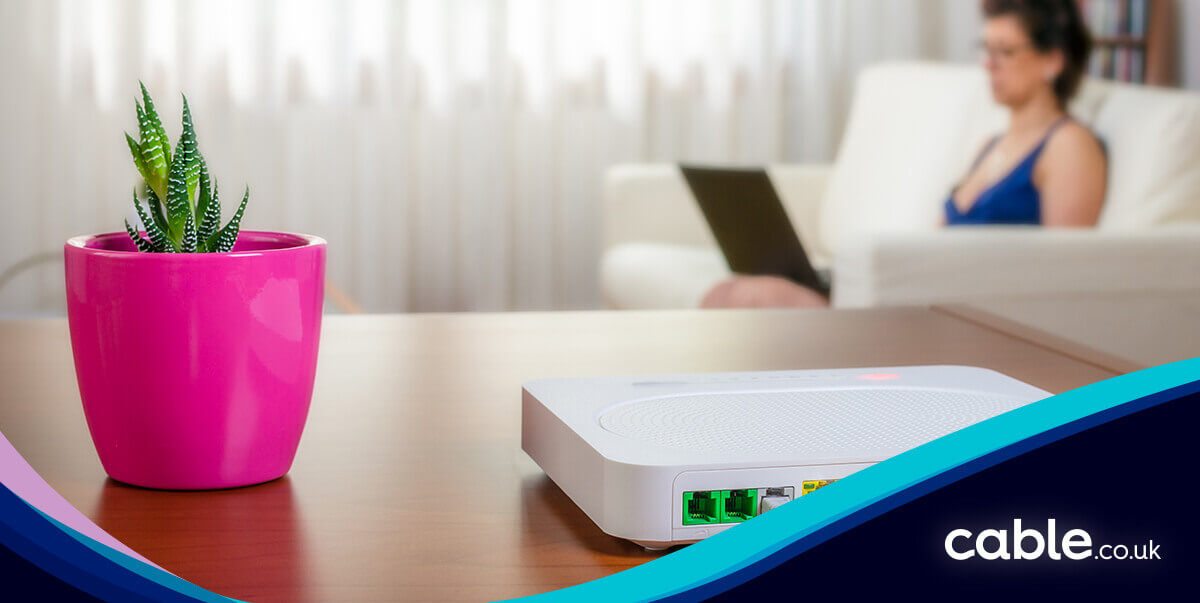Dan Howdle | June 12th, 2023
What is ultrafast broadband?
You've heard of superfast broadband, but now along comes ultrafast. Believe it or not these terms aren't just marketing fluff and actually have very specific definitions. So what is ultrafast? Do you need it, and can you actually get it?

As the name suggests, ultrafast broadband is an incredibly quick broadband connection. This is due to the fact that it uses full fibre cables, rather than a mixture of full fibre and copper that is used by superfast connections. So what do all these names mean? We explain all.
What is ultrafast broadband?
The definition of ultrafast
To define ultrafast broadband we must also define the other types of broadband you'll commonly find out there. That way we can get a sense of scale as to how much faster it is than the typical broadband deal.
Standard ADSL broadband is a connection with a speed of less than 24Mbps (megabits per second) that arrives at your property via copper telephone wires. This speed is no longer widely offered and is only available to those who have no access to any fibre services at all.
A step up brings you to the widely available 'superfast' broadband, which offers speeds faster than 24Mbps but slower than 80Mbps. These services use fibre optic cable and copper telephone wire so can offer faster speeds than standard broadband.
Finally 'Ultrafast' broadband is a pure fibre broadband service that allows for speeds up to 1Gbps (one gigabit per second, or 1000Mbps). It is widely referred to as Full Fibre by most broadband providers. As well as very high speeds, ultrafast broadband also allows for very reliable, stable speeds, which is why some providers will offer speeds as low as 74Mbps ultrafast for those that don’t need extremely fast speeds.
How fast is ultrafast broadband in real terms?
A lot of providers will sell you their broadband speeds on how much you can download and stream, and how quickly you can do it.
- Standard ADSL broadband (10Mbps-11Mbps) – Stream between one and two HD movies at the same time
- Superfast broadband (35Mbps-213Mbps) – Stream between four and 30 HD movies at the same time
- Ultrafast broadband (up to 1000Mbps) – Stream between 50 and 150 HD movies at the same time
If you're looking at those numbers and thinking 'Why on earth would I ever want internet fast enough to stream over a hundred movies at once?' then you are asking the right question: Do you really need it? Well, you might be surprised.
Compare ultrafast broadband deals
Do I need ultrafast broadband?
The need for broadband speed is now increasing all the time, with the introduction of UHD, and the endless smart devices available for the home. So whether you need these ultra high speeds for your home will come down to your own personal requirements. The average British household doesn't actually need all that much speed. Everyday uses such as surfing the internet or streaming movies and TV only start to tax your average connection when a few people in the household are doing them at the same time.
However, there are some special cases where an ultrafast connection might be desirable (if not absolutely necessary). If one or more people in the household is a gamer who regularly downloads their games from the internet, having a fast connection means doing so will take less time. Likewise if there are members of the household who like to stream movies and TV in 4K (a very high-definition screen resolution only available to the latest TVs), a faster connection is better.
As mentioned above, the number of smart gadgets you have in your home will also have an effect on what kind of download speed you need, since the more smart items you have, the more speed you will need. This covers everything from smart security software such as a Ring doorbell to smart entertainment items such as Google Nest.
If you have a relatively minimal smart home without too many people and gadgets online at once, then a superfast fibre connection is probably going to be enough.
-
 £50 Gift CardUltrafast
£50 Gift CardUltrafast- 145Mb average speed +
- Unlimited usage +
- PAYG calls
- £50 Gift Card
£29.00 per month(prices may change during contract)£50 Gift Card£5 one-off cost24 month contract -
 £50 Reward CardFull Fibre 100
£50 Reward CardFull Fibre 100- 150Mb average speed +
- Unlimited usage +
- No phone line
- £50 Virtual Reward Card
£29.99 per month(usually £30.99)(increases on the 31st March 2025 by CPI +3.9%)£50 Reward Card£31.99 one-off cost24 month contract -
 £50 Gift CardUltrafast + Wifi Max
£50 Gift CardUltrafast + Wifi Max- 145Mb average speed +
- Unlimited usage +
- PAYG calls
- £50 Gift Card
£31.00 per month(prices may change during contract)£50 Gift Card£5 one-off cost24 month contract
Compare broadband deals
Who offers ultrafast broadband?
All the major providers now offer ultrafast broadband. Sky, TalkTalk, EE, Vodafone, BT all offer speeds up to 900Mbps via the Openreach full fibre network. At the time of writing, this is available to around a third of UK homes, but that number is rising all the time as Openreach continues its rollout. Virgin Media also offers ultrafast speeds over its own network of cables, with a top speed of 1140Mbps available.
- Virgin Media – The original provider of ultrafast speeds Virgin Media still only covers around 70% of UK homes right now, though, so you'll need to check if you can get it at your postcode
- Openreach providers – All the providers that use the Openreach network offer the following speeds, or some slight variation thereof: 145Mbps, 500Mbps and 900Mbps. This applies to BT, Sky, EE, and Vodafone. TalkTalk and Plusnet also offer a lower full fibre speed of 74Mbps. Shell offers a wider choice of 100Mbps, 200Mbps, 300Mbps, 500Mbps and 900Mbps
- Hyperoptic and others – Some smaller providers use their own-built fibre networks to offer speeds of up to 1Gbps. The most notable of these is Hyperoptic, which continues to expand its network, but specialises in multi-occupancy urban dwellings
Can I get ultrafast broadband?
To quickly and easily find out if ultrafast speeds are available at your address, simply use the postcode checker tool below. This will bring up a list of all the ultrafast options available at your address, including Virgin Media packages. If no ultrafast options are available yet, you will be shown the best superfast fibre deals at your postcode instead.